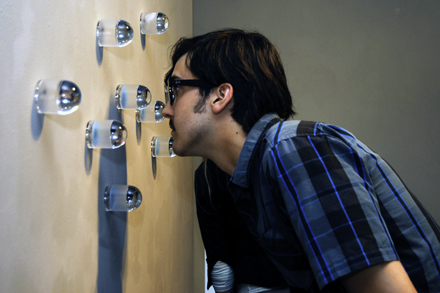Michelle Mayer: Departure/Return
Wally Workman Gallery, Austin
Lauren Adams
 Michelle Mayer, Heels for Departure I, 2011; mixed media (vintage heels, acrylic paint, foraged bark from New York City parks, moss and sculpted mushrooms); 11.5 x 13 inches in diameter; courtesy the artist and Wally Workman Gallery, Austin; photo by Michelle Mayer
Michelle Mayer, Heels for Departure I, 2011; mixed media (vintage heels, acrylic paint, foraged bark from New York City parks, moss and sculpted mushrooms); 11.5 x 13 inches in diameter; courtesy the artist and Wally Workman Gallery, Austin; photo by Michelle Mayer
 Michell Mayer, Diatomes 1-9 (installation view at Departure/Return, Wally Workman Gallery, Austin), 2011; marker on vellum within acrylic half dome; 2 x 2 x 2 inches each; courtesy the artist and Wally Workman Gallery, Austin; photo by Claire Anne Jordan
Michell Mayer, Diatomes 1-9 (installation view at Departure/Return, Wally Workman Gallery, Austin), 2011; marker on vellum within acrylic half dome; 2 x 2 x 2 inches each; courtesy the artist and Wally Workman Gallery, Austin; photo by Claire Anne Jordan
As former Austinite Michelle Mayer progressed through her master’s degree in interaction design at New York University, creating installations and performance works with cutting-edge (and frequently screen-based) technology, she began to feel disconnected from her physical surroundings. In order to understand, if not remedy, this detachment Mayer began experimenting with natural found objects and exploring her fascination with the various overlooked communities of organisms whose existence is so necessary to the vitality of larger ecosystems.
Departure/Return, Mayer’s solo exhibition at Wally Workman Gallery, highlights three recent projects that consider such human/nature interaction. Mayer’s interest in microscopic organisms appears in her collection of Diatomes (2011), representations of a major group of algae known as diatoms. Mayer depicts these single-cell life forms, one of the most common types of phytoplankton, as sketches on vellum. She houses each drawing in an acrylic half-dome such that each organism can only be seen clearly from up close. Viewing the work echoes the feeling of looking through a microscope. The domes focus viewers’ attention on these tiny organisms but also manifest a seemingly controlled and sterile man-made environment.
Even more engaging is Heels for Departure (2011), a collection of five pairs of vintage high-heeled shoes encased in layers of natural bark, some sprouting synthetic mushrooms. Mayer presents the craggy surface of these shoes, whose forms once emphasized youth and modernity, in a state of controlled decay. Housed in bell jars, the shoes seem preserved as they are and show no signs of further deterioration. These once-beautiful objects are a reminder that most things, even those carefully constructed by man, are ultimately reclaimed by nature. However, the presentation of the jars is yet another controlled environment that allows the viewer to observe this transformation. This question of who is really in control, humanity or nature, remains unclear.
The focus of the exhibition is the installation Root Boots (2011), which also became the stage for a performance by Mayer on April 5. Knee-high, bark-covered boots stand in a tiered forest setting among a mixture of both real and synthetic moss, mushrooms, dirt and bark. In the performance Mayer donned the boots and traipsed with difficulty around her forest, announcing she had begun her search for the foundation she had lost. The sound of creaking, protesting wood underscored her journey, and the forest floor vibrated as the invisible underground fungal network responded to her movement. Mayer invited the audience to join her and feel the earth’s vibrations themselves.
The irony here is that viewers became aware of Mayer’s unseen natural communities through the use of technology. Subwoofers lining the forest floor were connected to Mayer’s movements through sensors and radio transmitters in her boots. The invisible microscopic organisms thus audibly evoked also visually appeared briefly as moving projections on the wall and body of the artist. Without the hidden technology the installation wouldn’t be much more than a peaceful rendition of a forest.
With Departure/Return Mayer reaches out to viewers and invites them to richly experience these minute organisms and systems that she has come to value, and the labor and enthusiasm that went into creating this exhibition is impressive. However, Mayer’s work seems to raise more questions than it answers. She is certainly using technology to facilitate our understanding; however, she also emphasizes how humans tightly control much of the natural world. Could it be that we have lost the ability to appreciate nature in its natural state? Perhaps Mayer is struggling with this question herself.
Lauren Adams is the PR & Marketing Representative for Art Lies and holds a master’s degree in art history from University of Glasgow in conjunction with Christie's, London.
This exhibition will be on view through April 30, 2011.








